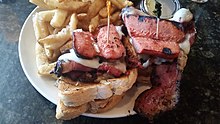|
Knackwurst
 Knackwurst (German pronunciation: [ˈknakˌvʊʁst] ⓘ) (in North America sometimes spelled knockwurst (ⓘ) refers to a type of sausage of northern German origin from the mid-16th century. The many available varieties depend on the geographical region of their production. Etymology and pronunciationThe German noun Knackwurst—which, in English, is sometimes corrupted as knockwurst—comes from the German verb knacken (ⓘ) ("to crack") or the adjective knackig (ⓘ) ("crisp"). This refers to the swelling of the sausage during the process of cooking, so that the skin becomes pressurized and balloon-like, and tends to "pop", often exploding the juices, when bitten into (authentic example: ⓘ). (Cf. the British term "banger".) Etymologically, the term "knackwurst" arose in Germany in the middle of the 16th century.[1] In Germany, all different kinds of Knackwürste are abbreviated Knacker (ⓘ).[2] Knackwurst in Germany & Austria
Numerous regional varieties of knackwurst exist in Germany. They all differ from knackwurst varieties sold in Austria. There, a knackwurst always refers to a sausage containing bacon and added potato starch. In addition to the term "knackwurst", common names are "Salzburger" or "Schübling".[3] As a specialty in Hamburg, scalded Knackwurst served with mustard and half a slice of white bread is a popular snack for lunch. It is also sold at the Hamburger Dom, the largest Volksfest in northern Germany, under various, sometimes poetic, names like Domknacker, Hamburger Knacker, or Hafenlümmel (literally: harbour tyke).[4] Knake in SwedenA knake refers to a short, plump and dark sausage which is produced by Holmgrens in the Swedish city of Lund. It is a Lund speciality and dates back to the 1910s. Today's recipe is dated to the 1960s.[citation needed] Knockwurst in the US In North America, a knockwurst refers to a short, plump sausage originating from northern Germany. It contains ground veal, ground pork, and fresh garlic stuffed into hog casings.[5] As part of the production process, the sausages are aged for two to five days, then smoked over oak wood. Knockwurst is often prepared highly seasoned.[6] Knockwurst is sometimes cut in half lengthwise before serving,[7] for example when served on a sailor sandwich.[8] See alsoWikimedia Commons has media related to Knackwurst. References
|
